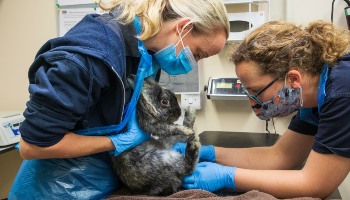Microchipping cats
Microchipping is quick and easy to get done, and it will help you get your cat back if they go missing.
New cat microchip law
From 10 June 2024, it will be a legal requirement in England to microchip your cat if they’re older than 20 weeks. Speak to your vet as soon as possible to avoid any waiting lists.
How much does it cost?
Prices typically vary between £10-£30. Only a trained professional such as a vet can fit your cat with a microchip. You can arrange an appointment at your local vet. Some animal charities and organisations also offer microchipping. Some will offer it free of charge.
How microchipping works
A tiny microchip (about the size of a grain of rice) is quickly and simply inserted under your cat’s skin, usually at the back of the neck. This gives your pet their own unique code. Once in place, it can’t be seen, but can be read by a scanner. Your cat won’t be able to feel the microchip once it is put in place, and the microchip itself shouldn’t cause any problems.
The microchip can be scanned and matched to the owner's contact details, which are kept in one of the national databases. There are over 20 microchip databases to choose from.
Find out if your cat is microchipped
Microchip registration
Find out where it's registered
Microchip details need to be up-to-date
If you move house or change your phone number you must make sure you tell the database you're registered with so that they have your up-to-date contact details. It can be near impossible to reunite pets with their owners if the owner cannot be contacted.
The vet practice you chose to microchip your cat will use a microchip assigned to a specific database. You must contact them to ensure that your latest address and contact details are registered on the database.
Frequently asked questions
-
All cat owners in England must ensure their cat is microchipped from 10th June 2024 as it will be a legal requirement under the Microchipping of Cats and Dogs (England) Regulations 2023. This means that you should have your cat microchipped before this deadline.
Only feral, farm, unowned and community cats who have little or no human interaction or dependency are exempt from microchipping and in all other cases owners found not to have microchipped their cat will have 21 days to have one implanted, or may face a fine of up to £500.
This law is only applicable to England at the current time, but we recommend that you get your cat microchipped regardless of your location. -
In England it's a cat keeper’s responsibility to ensure kittens are microchipped. Kittens cannot be sold until they're eight weeks old and the breeder may microchip a kitten before the animal is sold but if they do not the keeper of the cat must microchip them if they are over 20 weeks old.
The keeper must also register their details on the database, and their details will be recorded against the microchip for the life of the cat.
The same applies to rescue centres. If you are adopting a cat from a local rescue centre or an animal welfare charity they should be microchipped, and the organisation should give you all the information you need to update the details on the microchip.
If you're buying a kitten, make sure they're microchipped before they’re 20 weeks old. Take a look at our other advice on buying a healthy, happy kitten. -
If you’re rehoming your cat, you’ll need to contact your microchip database. You must complete the transfer of ownership document so that the new owners’ details will be on the list instead. The new owner is responsible for ensuring their contact details are registered.
-
In most cases microchips last for the pet’s entire lifetime. It is extremely rare for them to become faulty and can’t be read but if this does happen the manufacturer should offer a replacement. Your vet will simply place the new chip alongside it.
If you find that an implanted microchip has moved, failed or caused an adverse reaction in your cat, you should report it to the microchip adverse event reporting scheme. -
On the unfortunate occasion that your cat is lost or stolen, contact your microchip company to let them know straight away. It will be a legal obligation for them to record this. They will be able to check if your details are up to date, and flag your cat as lost or stolen. This way, they can contact you when your pet is found.
-
If your cat passed away you should report this to your microchip database so that their files can be updated. The microchip doesn’t have batteries or moving parts so there is no danger in cremating the microchip along with your pet’s remains.
Other benefits of microchips
Microchip cat flap
A microchip flat can be a very useful tool which can help you stop cats other than your own from entering your home. The flap can be programmed so that it only recognises your cat’s microchip allowing them to enter your home, while keeping other cats and wildlife out. If you own more than one cat, you can register them all to the same cat flap so they can access your home through the same entrance.
Microchip food bowl
A microchip food bowl uses your cat;s microchip to control their access to food. This is ideal if you own multiple cats, if you’re suspecting that other cats are eating your pets food or if you need to restrict your own cat’s diet.



